American Sabbatical 72: 3/17/97
Brookgreen
3/17.. Brookgreen.
| Yesterday, sitting on the rise above Moores Creek and perusing the map, I noticed we were only
a stonesthrow from Lake Waccamaw, and following the serpentine
blue line running out of it into Horry County, S.C., the penny
dropped. Horry and the Waccamaw. That’s the title of a book by our Maine neighbor Frank Burroughs
about the country he grew up in. |
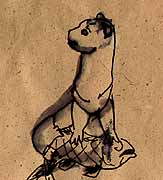
Bryce is on Brown
|
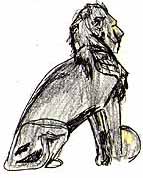
Peggy is on white
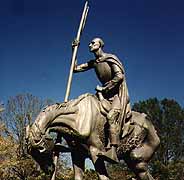
Photos by Peggy
|
I’d never read it, despite the fact that Frank’s first book of
essays, Billy Watson’s Croker Sack, had been an elegant collection of yarns, mostly about Bowdoinham.
I’d tried to get a copy before we set out, discovered it had been
republished in paper as River Home, and was unavailable. But here
we were on Frank’s native turf, and considering that our home
ranges now overlap.. and how different his take on our back forties
is from mine.. I was curious what he’d said about this unprepossessing
terrain. |
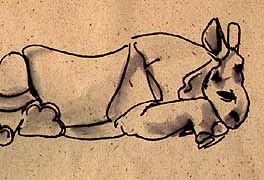
So Monday morning began with a book quest. We gassed the Owl,
coffeed the navigator, got scolded at BP for not wearing of the
green (“You might get pinched today.”), and pointed it toward
Wilmington and the big book chains.
|
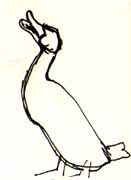
|
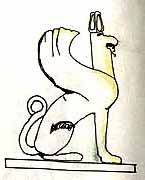
|
When you actually seek out WAL*MART country, a city like Wilmington
shows her contemporary face, full of gas fumes and the roar of
the pavement. I realized that the ugly sprawl we’ve made of our
cities and burbs over our lifetime may actually have been the
saving of the old city cores. Capital flight from downtown meant
a dispersion of the automotive pressures, and, where the core
hasn’t be “renewed’ with bulldozers, the old heart of town may
still be beating.. to a slower drum. Granted, these old centers
may only have tourist trade, but that knocks Azalea Mall on the
head. |
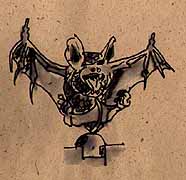
Bat
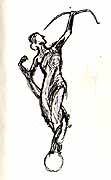
Diana
|
And no one wants to remember the old backwater at all, or at least
keep Frank’s book in stock, so we fled the commercial excitement,
climbed the bridge above Battleship Park, and spread out across
the alluvial plain. We’d been told that Airlie Gardens were not
to be missed, and in this blooming weather we wanted to get a
nose full. But, yikes.. we’d missed the turn. Somewhere in Mall
City the signs had gotten too thick, and we were halfway to Myrtle
Beach before we realized that the gardens were down a peninsula
on the other side of the Cape Fear. Our recommendation had come
from a sailor who traveled this coast via the waterway, and when
those guys get lost they’re still where they want to be. With
that attitude, we trimmed our sails and scanned the horizon for
another azalea garden. One of those days.
|
The South Carolina pines were looking a lot healthier here than
in the war zone behind Topsail. IP and GP plantations ran along
the roads like open parklands, either clear of undergrowth, or
waisthigh in spring pastels. Festoons of wisteria vines draped
lavender sprays where they climbed on the paper factory. Even
the downscale dooryards showed more house pride: stonework set
pieces with lots of cement kitsch, luxurious flowerbeds, and rows
of cactii!! The pricklypears seem to love it here, and we hadn’t
seen rows of the spiny things since the Baja. Other tropical indications
were sprouting up. Palms and palmettos line the road, and had
escaped to (or were indigenous to) the backlands. But the crowning
decor may have been the lurid paint jobs on the cinderblock chalets.
Wicked good. You get a good torquing here between the plantation
manses and the tinroofs.
|

Dianae
|
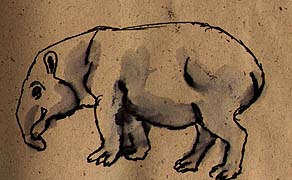
Patchenesque
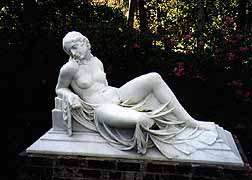 Note the Flowers Note the Flowers
|
We carried on for Myrtle, and knew we were getting close when
the sandtraps and greens began to straddle the road. And HEY,
it’s Spring Break time, and the beer fumes compete with the octanes
on this strand.
|
| The Grand Strand. Before the intercoastal ditch was dug this was
the long outside passage between the Chesapeake and Florida. North
and south were barrier islands a coaster could scooch behind in
a blow, but from Cape Far to Charleston only the river mouths
offered shelter, and behind the shore dunes the swamplands were
left to their lazy solitude. The Swamp Fox, Francis Marion, had
used this wilderness as the base for his guerrilla campaigns,
which kept the British confined to the coastal harbors during
the Revolution. Now the foreshore is beachfront real estate, and
the back country has been ditched and harvested by corporate giants.
The longleaf pines of old went for naval stores over centuries,
but the loblolleys that replaced them come down in rotation for
International Paper and Georgia Pacific.. or before a big wind.
Wetlands close to the beach get filled and turned into golf courses
and retirement condos. This month the age segregation is a bit
weird, elders and college kids, a volatile mix, you’d think. |
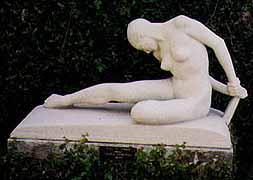
Arms Back
|
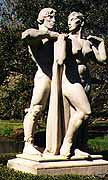
See Background
|
Coming onto the grand strand at the north end of Myrtle Beach
the coast road turns into a honkeytonk, in the sand between your
toes tradition. Irish bars offering green beer and wet T-shirt
competitions, towel outlets and beachparty outfitters, massage
and tanning parlors and Hooters franchises (bring you own boobs).
We didn’t see a BrewThru (we passed one at Nag’s Head), but the
topdown jockeying at the stoplights, and the rebel yelling argued
for cruising into a motel before dark. |
We were hoping for an inexpensive seafood joint to ease the pangs,
but the Paddy’s day specials of Corned Beef and Crab Legs just
didn’t grab us. Crossing the line into Myrtle proper we knew we’d
arrived at a cultural height. There among the palmettos were two
exemplars of monumental Neo-Georgian Mosque: The Carolina Opry
Theater and Hotel. Loretta Lynne on stage Saturday. Then the billboards
for Elvis impersonators, and exotic dancers. Sigh.
|
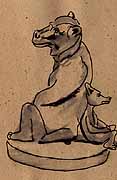
|
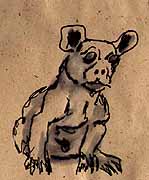
|
When we finally deserted the fourlane lined with steak and pancake
houses, looking for a town center and maybe a place with vegetables,
all we found were carnival rides and big chain hotels lining the
waterfront. I felt overdressed without Bermuda shorts and a muscle
shirt, or a beer belly and a butch haircut, for that matter. Peggy
wondered why there were no topless clubs called Geezers. We didn’t
even stop for the 2fora$ rude Ts. Culture snobs, I guess. |
In the end we settled for fresh baked bagelbuns (no hole) with
lox and creamcheese at a roadside bagelorama. So when did bagels
become a national food? Was this another conspiracy of the New
York TV cabal?
| Red’s navigator had been grinning all morning about our destination.
I figured it was yet another posh plantation, this one called
Brookgreen Gardens. Which forgotten president was born here? It
wasn’t even easy to find. We circled round south of Myrtle, skirting
Murrells Inlet, and other feral rice plantations. When we finally
drove up to the gatehouse, my heart sank.. it’s a sculpture garden
full of traditional monumentalism.. 500 pieces worth! And the
parking lot is full of bluehairs. |
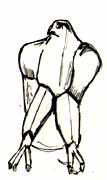
|
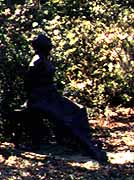
|
I was muttering before we even set out around the grounds. By
the gift shoppe there was an installation of lifesize bronze children
saluting the flag, which one boy has hauled up a pole. Sheesh.
And all these manicured lawns and fountains and monumental settings
among gigantic live oaks and other excessive foliage. The whole
shebang was created by a branch of the Huntingtons, and guess
which sculptor is prominently featured.. a Huntington. I was getting
queasy.. a touch of museumitis coming on. |
(Memo #65)
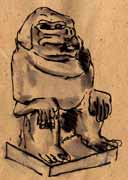
Bryce
|
March 1 Brookgreen Gardens, N.C.
Who? Archer and Anna Hyatt Huntington
What? realistic pieces by 500 sculptors
Where? Murrells islet, N.C., near Myrtle Beach
When? begun in the 1930’s
How? site of rice plantation made into gardens
Topics: American art, sculpture, realism, representational art
Questions: How is sculpture best exhibited? Are there many unknown
American sculptors?
|
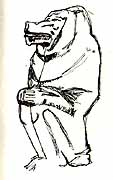
Peggy
|

Bronze

Couple
|
2000 plant species bloom and trail and grow in the Huntingtons'
gardens. The many acres are divided into lawns and gardens and
parkland. There are hedges and walls and loggias and fountains
and sunken gardens and fountains and pools and cloisters and small
galleries. There are grand vistas down live oak lanes or across
sweeps of lawn that end at huge pools with monumental sculptures
in the middle. There are intimate nooks with marble seats behind
azalea shrubbery or under arbors or through arches. There are
formal gardens with interlocking geometric flower beds and naturalistic
sweeps of shrubs and flowers. The scrub pine woods of the seaside
sand barrier island have been turned into a huge outdoor fantasyland.
Brookgreen is beautifully designed and exquisitely tended.The
lawns are mowed, the flowers and fruit trees are blossoming. And
every fifty feet or so there is a sculpture. |
| The sculptures are in pools and fountains and niches. They stand
on gateposts and walls and pillars. Dozens more stand on plinths
in open air galleries. Five hundred sculptures in all. There are
rabbits and bears and herons and alligators and ducks and swans
and deer and lions in bronze and marble. They are running, feeding,
fighting. Heroes sit astride giant horses, mothers cuddle children,
dancers twist and jump, and numerous Dianas shoot arrows into
the sky. They all are realistic sculpture, but the poses and subjects,
the styles and size vary greatly. |
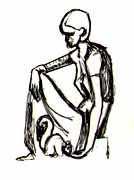
|
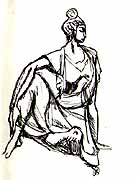
Proud
|
How many American sculptors can most people name? I remember Remington
and Saint Gaudens and Daniel Chester French from a history of
art course, and Gutzon Borglum from a visit to Mt. Rushmore. Brookgreen
showcases these and dozens more! |
| Henry Clews Jr., Isidore Margulies, Brenda Putnam, Mary Abastenia
St Leger Eleve, Anna Hyatt Huntington, Solon Borglum, Malvina
Hoffman, Glenna Goodacre, Charlotte Dunwiddie, Horatio Greenough,
Gertrude Vanderbilt Whitney, Lorado Yafy, Walter Kirtland Hancock,
Janet Scudder, George Gray Barnard, Charles Grafly, Paul Bartlett,
Hiram Powers, Derek Wernher, William Zorach, Grace Talbot, Adlai
Horden, Cecil Howard, Alice Morgan Wright, Constance Ortmeyer,
Pietro Montana, Eugenie Shonnard, Janet de Coux, Mahonvi M. Young,
Betty Branch, Marjorie Daingerfield, Carl Milles are all represented
and I have omitted dozens. It is a staggering display of talent. |

|
We wandered happily for hours and didn’t even get to the separate
wildlife park.
3/17.. cont.
We didn’t need to, the sculpture gardens were wild enough.
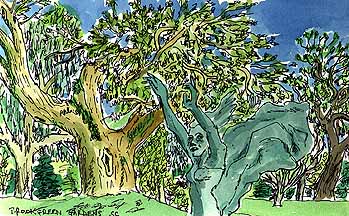
Brookgreen by Bryce
I confess: I was won over. And by a Huntington sculpture, no less..
a gigantic Don Quixote and Sancho Panza with their steeds. OKOK,
I’m a little slow responding to formal presentations, but Sancho
muttering to his donkey sarcastically while the Don, rigidly upright
in his tattered array urges his jaded nag into another romantic
folly, 15 feet tall, cheered me out of the sneers. And the two
baboons flanking the next entry frosted my cake. From then on
I could look at the sculpture and enjoy the formal beauty of these
glorious gardens in bloom.

Fisherman
|
A tour de force of modern representational sculpture. Not a single
abstract piece to be seen (which lack, I was surprised to discover,
actually bothered me.. for all the terrible MODERN sculpture out
there, the good stuff says things no other form can). But how
wonderful to be able to gorge on one menu to utter repletion.
And it’s fascinating how antique themes persist in twentieth century
expressions. There must have been a dozen Dianas hunting by moonlight
(or in 80 degree sunshine), and fauns and nymphs galore. The animal-cross
genre I’ve worked so hard was well represented (although not as
insulting portraits, I’d note), and the mythic animal assemblages
had some new syntheses.. a leaping horse-dolphin in particular.
There might have been a tad too many children hugging cute animals
for a grumpy old carver, but they were redeemed by one young woman
with a faun that bumped the motif into a higher orbit. |
| Finally it was the body language of these perfected forms that
lifted this collection out of the mundane garden kitsch (Estate
Monumental) into an experience to raise the spirit. A Nova Scotia
fisherman seated on a piling put me in one familiar place, and
I remembered my muscles ache.. while the twisted torso of an idealized
woman reaching for the ground gave me vertigo. A large greenbronze
figure of a dancing woman, flinging her drapes among the writhing
oaks, made me spin and wave my arms in the air. The Greeks brought
expression of the human form to its highwater mark, but the 20th
century let those bodies dance all the seadeep mysteries. |
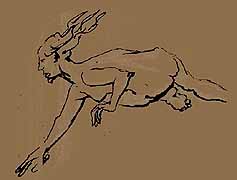
Bryce on Bronze
|
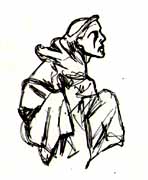
|
Gee, folks.. this traveling is not easy on your complacent assumptions
and prejudices. I’ve written off contemporary monumental sculpture,
representational and abstract, as a cheap trick for so long that
the crow I have to swallow is about six foot tall. The proof of
this pudding was watching Peggy sketch madly in her book. I’ve
been real good about drawing everyday, it’s my ritual therapy,
but Peggy hasn’t touched her art tools since we left home... these
sculptures were too much for her to ignore, however, and her drawings
jumped off the page at me.. making my inkwashes pale and insubstantial.
We got hooked and went from meditation to meditation until closing
time ran us off the grounds. Sketching together in such a wonderland
is exciting, and we came away with our eyes wide, and our smiles,
too. |
| By the time the Owl had flown off the strand and across the Pee
Dee, the shadows were getting long, and the old city of Georgetown
looked pretty good to us as a place to doss down. We cruised downtown,
scoping out the Rice Museum and the grand houses for tomorrow,
then checked into the EconoLodge by the causeway. |
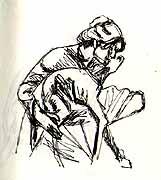
Fawn
|
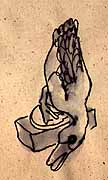
|
Not a minute too soon. St. Patrick’s revenge struck just as we
pulled into the motel lot: a screech of brakes and a crunch of
iron folded two beaters into a heap of junk. Nobody hurt. Not
us. Another round of green beer, Paddy. |
| We figured on another night of highway ambiance, and were stunned
to pull open the back drapes on a long vista of abandoned rice
fields glowing in the low-angled light, and the intercoastal markers
marching out of sight. |
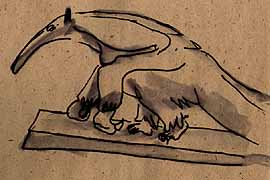
|










 Note the Flowers
Note the Flowers


















